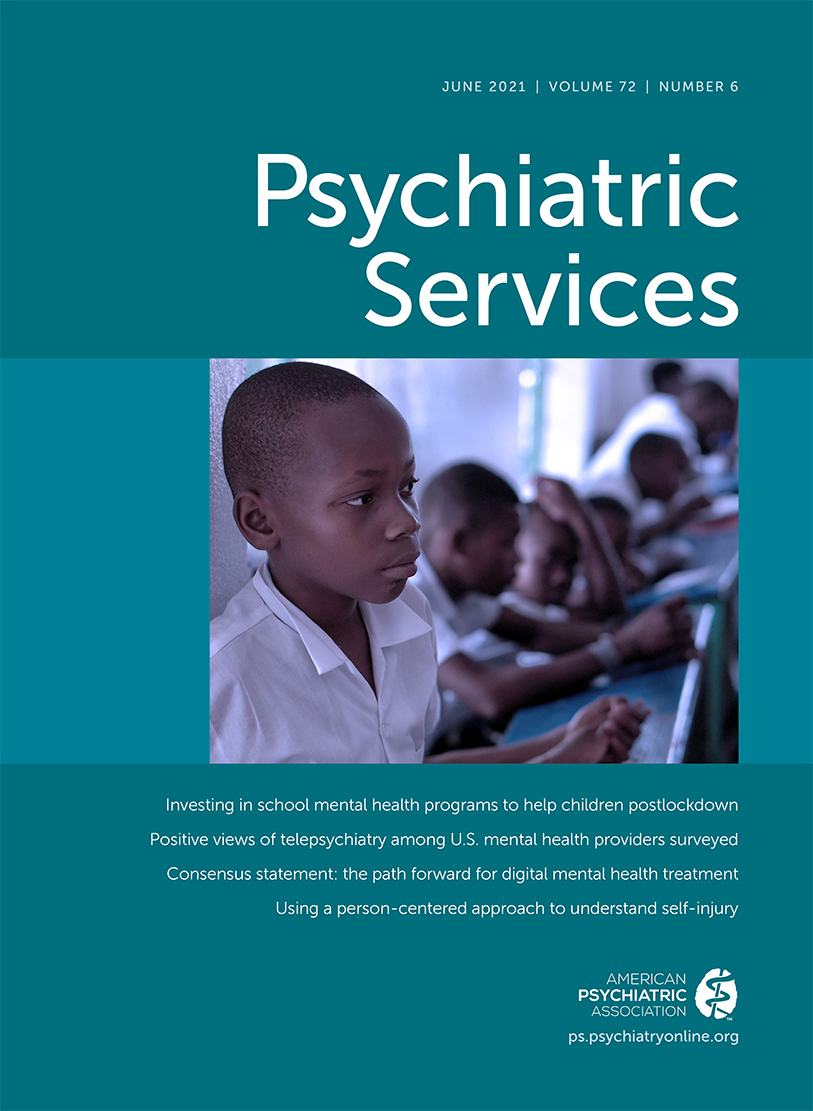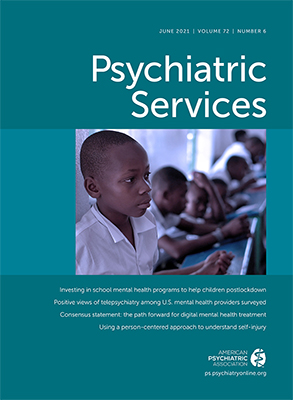Telehealth refers to providing health care remotely and is not a new concept. As early as 1878, the use of the newly invented telephone was suggested to reduce unnecessary office visits (
1). Since then, a substantial body of scientific literature supports the notion that reliability, effectiveness, and outcomes of telehealth applied to psychiatry, that is, telepsychiatry, are comparable overall to in-person care across multiple disorders, treatment modalities, and patient populations, and telepsychiatry is also cost-effective (
2). Despite this, however, telepsychiatry implementation was previously limited and restricted to a subset of unevenly distributed clinics and clinicians, although previous studies have reported generally positive clinician and patient attitudes (
3).
This dissociation may have been driven partially by implementation or technical difficulties, organizational culture limitations, and reimbursement problems (
4). However, a selection bias is also likely (
5), with younger, digital-native, or technically savvy professionals tending to take part in telepsychiatry pilot programs and subsequent satisfaction surveys and a larger population of clinicians who would have reported more barriers possibly remaining underrepresented. Furthermore, as we transition to multidisciplinary care, the opinions and attitudes of other professionals beyond just physicians are important.
Because of the COVID-19 pandemic, many health care systems around the world were forced to massively and rapidly transition all or almost all visits to telepsychiatry, a shift that was accompanied by a significant regulatory relaxation (
6). This unprecedented scenario provided a unique opportunity to qualitatively assess the attitudes and opinions of mental health care professionals in diverse clinical settings.
Methods
A survey was locally distributed to all clinicians at 18 hospitals and community centers affiliated with the Vanguard Research Group, a research consortium specializing in behavioral health research, in 11 different U.S. states. Psychiatrists, psychologists, nurses and nurse practitioners, social workers, therapists, mental health counselors, residents, and fellows were invited to complete the survey anonymously. The surveys were distributed in April and May 2020 and could be completed electronically. This study was carried out in accordance with the Declaration of Helsinki (
7). Study procedures were considered exempt from review by our local institutional review board.
The survey included 12 questions about satisfaction with telepsychiatry in its different modalities and used a 5-point Likert scale, as well as questions about potential challenges and positive experiences (the survey is available as an online supplement to this report). Descriptive statistics were used to report qualitative survey results. Chi-square tests were used to compare categorical variables. First, omnibus comparisons were conducted by age and professional category. If statistically significant differences were detected, we tested the individual interactions of interest post hoc. All data were analyzed with JMP (version 13, SAS Institute).
Results
The survey was distributed to approximately 2,000 mental health care professionals, of whom 837 completed the survey (response rate=42%). Eighteen participants disclosed that they had not used telemedicine and were therefore excluded. Hence, 819 surveys were included in this analysis.
Characteristics of the respondents are described in the online supplement. Briefly, respondents were distributed across all age groups, with 39% (N=318) of the sample being >45 years old. The respondents worked mostly in adult outpatient clinics (N=458, 56%) and child and adolescent clinics (N=148, 18%). They used mostly a combination of two-way video and telephone (N=500, 61%). Conversely, telephone alone or video alone were used less frequently (N=273, 33%, and N=45, 6%, respectively).
The overall experience was excellent or good for 73% (N=397) of the respondents who were asked about their experience with two-way videoconferencing and for 66% (N=523) asked about telephone only (see online supplement). Only 4% and 3% of the respondents using videoconferencing or telephone, respectively, declared that their experience was “poor” or “very poor.” We detected no statistically significant differences in the overall experience among professional categories. We also observed no statistically significant differences by setting or program.
Some of the challenges health care providers reported with telepsychiatry included inability of the patient to properly use the conferencing devices (N=422, 52%), lack of sense of closeness or connection (N=379, 46%), and technical problems (N=323, 39%) (
Table 1). We detected no significant differences in reported challenges among the professional categories of the health care providers, but challenges differed by provider age (χ
2=112, df=84, p=0.023), driven by a higher proportion of difficulties related to the use of technology or applications in both the 55–64-year-old (χ
2=13, df=1, p≤0.001) and the 65–74-year-old (χ
2=5, df=1, p=0.022) groups, compared with other age groups.
As an advantage of telepsychiatry, health care providers reported flexible scheduling or rescheduling (N=633, 77%), followed by timely appointment start (N=568, 69%) and lack or reduction of no-shows (N=427, 52%) (
Table 1). The reported advantages of telepsychiatry did not significantly vary by age but by the professional categories (χ
2=133, df=99, p=0.013). Care coordinators and managers as well as residents and fellows reported lack or reduction of no-shows less frequently than did the rest of their peers (χ
2=10, df=1 p=0.002, and χ
2=5, df=1, p=0.031, respectively). Psychologists and therapists endorsed the value of having access to the patient’s environment more frequently than did the other professionals (χ
2=6, df=1, p=0.011).
Psychotic disorders were considered the least appropriate diagnosis to conduct telehealth (N=438, 67%), whereas anxiety disorders were considered the most adequate (N=683, 96%). Clinicians considered that the future use of telehealth will mostly be determined by patients’ preferences and requests (N=553, 69%) and severity of symptoms (N=500, 62%) (see online supplement). In total, 34% (N=275) of the respondents indicated that after the COVID-19 pandemic has resolved, they would want to continue using telepsychiatry in ≥50% of their caseload, and an additional 30% (N=242) would like to keep using telepsychiatry in 25%−50% of their caseload. Last, 35% (N=284) of respondents would want to continue using telepsychiatry in <25% of their caseload.
In the free-text comment section, clinicians reported finding telepsychiatry to be generally useful and time saving. Concerns were raised about technical difficulties, and providers suggested administering specific, tailored support services for telepsychiatry-providing clinicians and facilitating clinicians’ remote access and ability to edit the patients’ medical records, thus smoothing the workflow and ensuring proper reimbursement from payers. Furthermore, mental health care professionals highlighted the fact that many patients do not have access to video platforms, forcing the provider and patient to conduct visits telephonically despite both parties preferring two-way video.
Discussion
In this study, we report highly favorable attitudes toward telepsychiatry in its diverse forms, across a large and wide array of mental health care professionals. To our knowledge, this is the largest evaluation of mental health care providers’ attitudes toward telepsychiatry to date, which is timely in the context of the current COVID-19 pandemic and the widespread stay-at-home and travel restriction orders, the durations of which are unclear. Furthermore, most of the responders would like to continue using telepsychiatry for a significant portion of their caseload after the current COVID-19 outbreak has been resolved.
In line with our results, previous studies that also have used qualitative self-report questionnaires, interviews, or both have shown that psychiatrists have overall positive attitudes toward telepsychiatry (
8–
11). However, studies focusing on groups other than psychiatrists are less abundant. Some studies have focused on perceptions of primary care providers (
12), emergency room physicians (
13), and resident and medical students (
14), but considerably less research is available on the attitudes of other mental health care professionals toward telemedicine or remote interventions. A recent review focused on technology-based interventions involving social workers revealed overall positive attitudes toward telepsychiatry use (
15), although this review included only five studies, some of which reported the results of specific interventions, and not all of which were conducted live or administered as part of regular clinical care.
Limited patient or provider access to technology, lack of proper technical training, and lack of specialized technical assistance in cases of technical need arose as potential barriers to telepsychiatry implementation and will need to be addressed by providers, payers, and regulators. Technical problems may make engagement difficult and also may hamper a provider’s ability to detect subtle forms of a patient’s body language, nonverbal cues, or even general medical symptoms of disease, a finding that has also been reported previously (
3). Patients with sensory and cognitive limitations would require deployment of additional technologies or human resources. With the currently available technology allowing for encrypted, safe, and private communications, videoconferencing should be preferred over telephone-based teletherapy whenever possible. Our results and other surveys back this preference (
10).
An important additional finding was that 64% of the respondents indicated that they wanted to continue using telepsychiatry for at least 25% of their caseload after the COVID-19 pandemic. This finding is relevant given the diversity and size of our sample, which was one of the strengths of this study. We maximized sample representation by partnering with a large network of community, real-world, and academic mental health centers distributed across the United States. Given the abrupt and widespread transition to telepsychiatry due to the COVID-19 outbreak, including providers who had never used telepsychiatry before, we aimed to capture the attitudes of a larger, more representative population of providers who may have been underrepresented in previous studies (
5). In fact, nearly 40% of our sample was ≥45 years old, and most worked in outpatient services. Hence, our findings should contribute to easing concerns about mainstream provider adoption and widespread telepsychiatry use. All stakeholders involved should ensure that the current reimbursement flexibility related to the COVID-19 pandemic remains in effect after the outbreak has ended.
Some limitations of this study need to be considered. First, our sample was not randomly selected, and therefore unwanted selection biases were possible, potentially hampering our efforts to represent the broader universe of mental health providers. Second, because this was a survey study, nonresponse and response biases might have occurred. Longitudinal studies will be needed to assess whether the transition to telepsychiatry has had any impact on outcomes for patients, including relapses or hospitalizations.
Whether and when the current travel restrictions and lockdowns due to COVID-19 will be lifted is presently unknown. Even when they are lifted, they may need to be reinstated if a new COVID-19 infection peak arises. Therefore, the current situation of widespread telepsychiatry-based assessments may endure, providing a unique opportunity for the study of telepsychiatry. Moreover, mental health care professionals’ concerns about access to technology, patient and provider training, and technical support need to be addressed if global implementation of telepsychiatry is to succeed.
Conclusions
Mental health care providers generally had a positive attitude toward telehealth, and many stated that they would like to continue using it with a significant proportion of patients. Timely starts of therapy appointments and a reduction or elimination of no-shows were commonly reported advantages of telepsychiatry. Concerns about proper access to technology and training for both providers and patients need to be addressed.
Acknowledgments
The authors thank the health care providers at Zucker Hillside Hospital, Cherry Health (Medical and Behavioral)–Heart of the City Health Center, The Mental Health Center of Greater Manchester, Peace Health, John Peter Smith Health Network, Charleston Dorchester Mental Health Center, Medical College of Georgia at Augusta University, Life Management Center of Northwest Florida, The Providence Center, Tri-County Mental Health Services, Federation of Organizations, Psychiatric and Behavioral Solutions, and The Harris Center for Mental Health and IDD for answering the survey.

